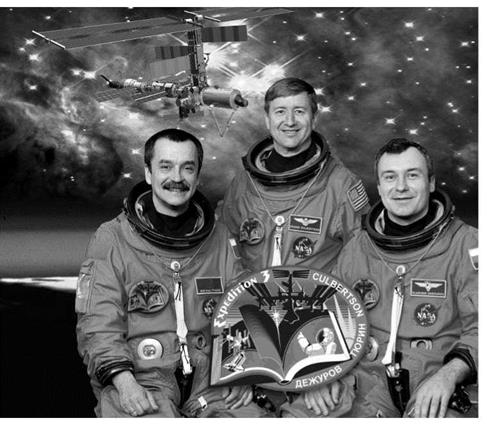ISS EO-3
|
Int. Designation |
N/A (launched on STS-105) |
|
Launched |
10 August 2001 |
|
Launch Site |
Pad 39A, Kennedy Space Center, Florida |
|
Landed |
17 December 2001 (aboard STS-108) |
|
Landing Site |
Shuttle Landing Facility, KSC, Florida |
|
Launch Vehicle |
STS-105 |
|
Duration |
128 days 20hrs 44 min 56 sec |
|
Call sign |
Uragan (Hurricane) |
|
Objective |
ISS-3 expedition crew programme |
Flight Crew
CULBERTSON Jr., Frank Lee, 52, civilian, US ISS-3 commander, 3rd mission Previous missions: STS-38 (1990); STS-51 (1993)
DEZHUROV, Vladimir Nikolayevich, 39, Russian Air Force, ISS-3 Soyuz
commander, 2nd mission
Previous mission: Soyuz TM21 (1995)
TYURIN, Mikhail Vladislavovich, 41, civilian, Russian ISS-3 flight engineer
Flight Log
The third resident crew, under the command of American astronaut Frank Culbertson, arrived at the station aboard STS-105 on 12 August for a four-month stay. During their residency, having assumed official command of the station on 17 August, the crew received two Progress re-supply vehicles, the Russian EVA and docking compartment and the second Soyuz Taxi crew. Four EVAs were also completed, but they did not receive any visiting Shuttle missions until STS-108 arrived to take them home, bringing the ISS-4 crew up to replace them.
The science programme for the mission involved 15 US experiments, 22 Russian, 3 Japanese, 4 French, a Canadian and an ESA experiment, some of which would be performed during the visiting mission. The research fields included biology, the environment of the ISS, radiation, Earth observations, geophysics, protein crystal growth, tissue growth, medical, materials science, technology and education.
Progress M45 arrived on 23 August and remained docked until 22 November. It would be replaced by Progress M1-7, which initially failed to hard-dock with the station and required an unplanned EVA to remove an obstruction to allow the docking operation to be completed. The other unmanned docking with the station during this residency was with Progress M-SO1, which delivered the Russian Docking Compartment (called Pirs, or “Pier”). A few days after docking, the instrumentation and propulsion sections of the Progress were discarded, leaving the forward module section of the vehicle (Pirs) permanently attached to Zvezda’s nadir port (which had
|
The formal picture of the ISS-3 crew posing for the traditional pre-launch crew photo in Shuttle launch and entry suits proudly displaying the residency logo. L to r: Tyurin, Culbertson, Dezhurov |
been prepared during the IVA of ISS-2 on 8 June). This new module would be used by crews performing EVAs from the Russian segment of the station.
The first EVA from Pirs was conducted by Dezhurov and Tyurin (8 Oct for 4 hours 58 minutes) and involved the installation of external equipment to bring the facility up to operational status. The cosmonauts also commenced construction of the Strela boom (GStM-1) designed for further movements across the station’s Russian segments, and installed some antennas. During the second EVA (15 Oct for 5 hours 51 minutes), the cosmonauts deployed several small experiment and materials sample cassettes on the outside of the station. These were long-duration exposure facilities that would be retrieved and replaced at regular intervals on future EVAs. The Soyuz TM32 was relocated to the rear Pirs docking port on 18 October in preparation for the arrival of the second visiting crew. The two Russian cosmonauts and French ESA astronaut Claudie Haignere (formerly Andre-Deshays) arrived on 23 October for a week of science activities. They would depart in the older Soyuz TM32 spacecraft leaving a new vehicle for the ISS-3 crew to use in the event of an emergency. The third EVA (12 Nov for 5 hours 5 minutes) involved Frank Culbertson, who accompanied Dezhurov outside to continue the installation of handrails and cables on the outside of Pirs and Zvezda. They also tested the extension of the Stella cargo crane, as well as inspecting and photographing a solar battery which had failed to deploy from Zvezda after entering orbit and had remained stuck. The final EVA (3 Dec for 2 hours 46 minutes) was completed by Dezhurov and Tyurin and was unplanned. They inspected the aft port of Zvezda where Progress M1-7 had failed to hard-dock and reported the presence of a foreign object, a sealing ring left behind by the previous Progress (M45) when it undocked. Ground command signalled the Progress M1-7 to extend its docking probe, allowing the cosmonauts to use a cutting tool to remove the tangled rubber ring and free up the system to allow the Progress to successfully hard-dock with the station. A few days later, STS-108 arrived, and the third expedition drew to a close.
Frank Culbertson had been a former US manager of the Shuttle-Mir programme and had used this experience to evaluate the working conditions on the new station for future US resident crew planning, experiment and logistics activities. One of the more difficult periods on board the station was in the aftermath of the 11 September 2001 attacks on the US. Informed of the day’s events during a medical check-up, the station later flew over New York and the crew saw the huge plume of smoke and dust from the attack and subsequent collapse of the World Trade Center buildings. Regular updates were sent to the crew following the attacks.
Milestones
3rd ISS resident crew
2nd ISS EO crew to be launched by Shuttle 1st EVAs by ISS resident crew











